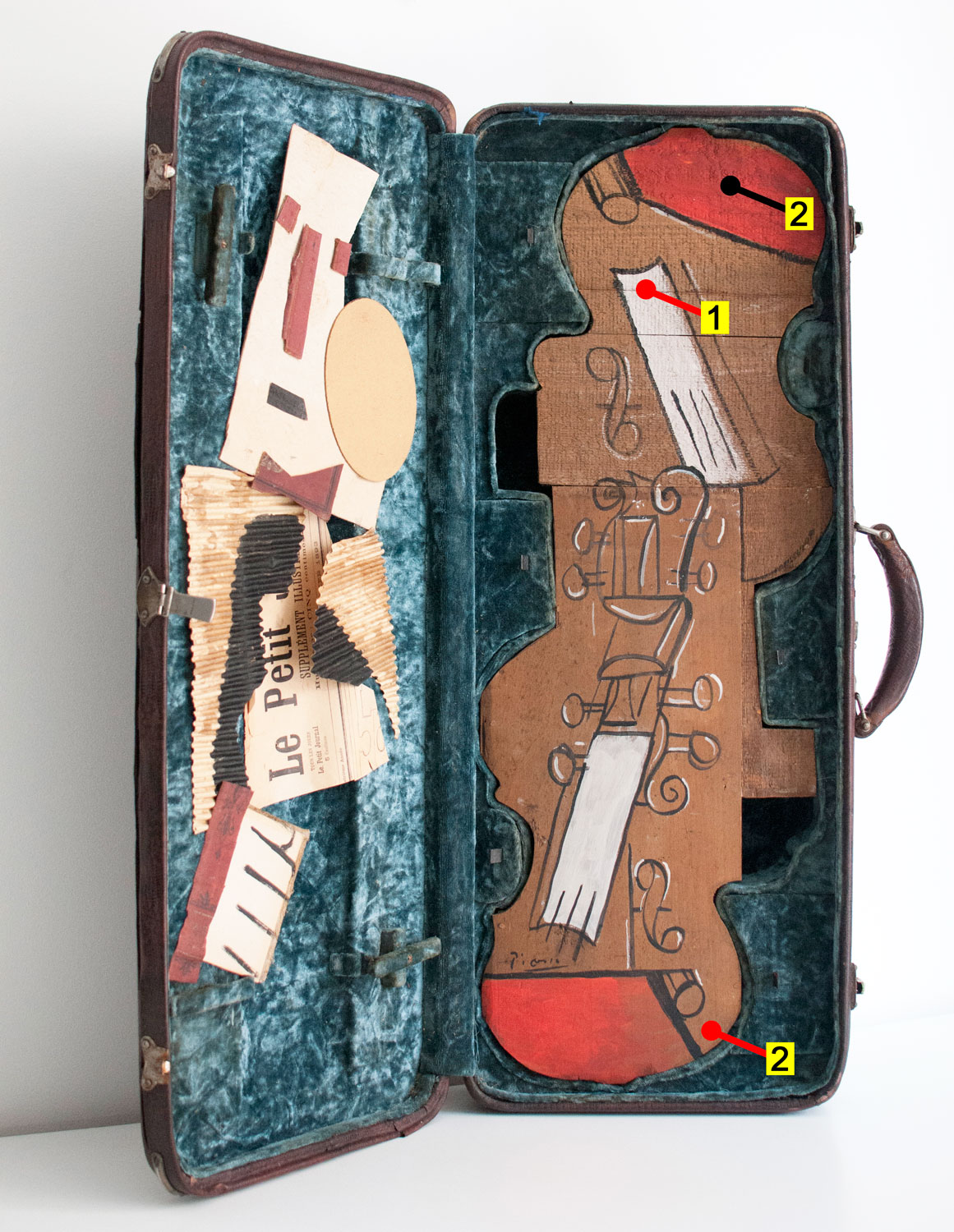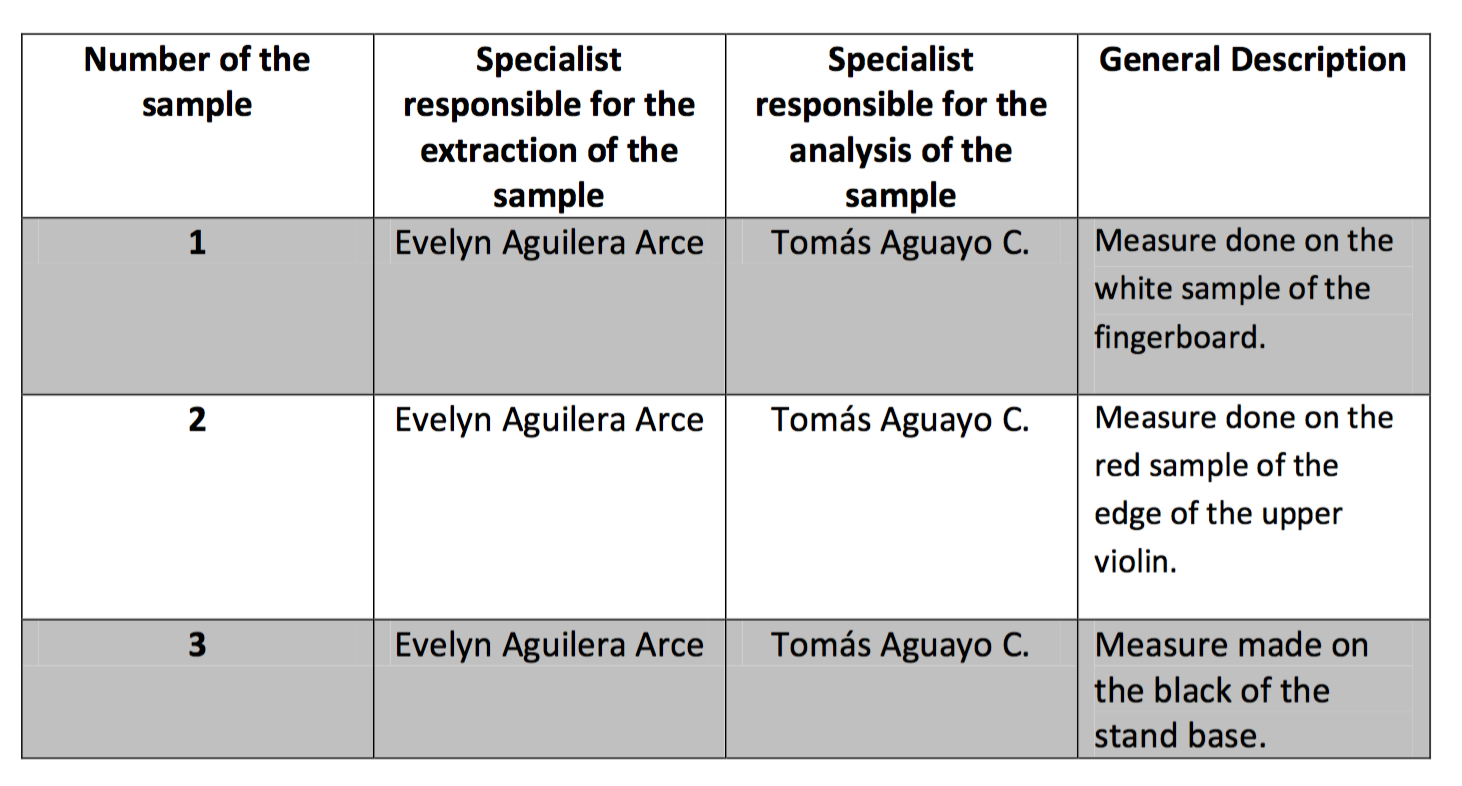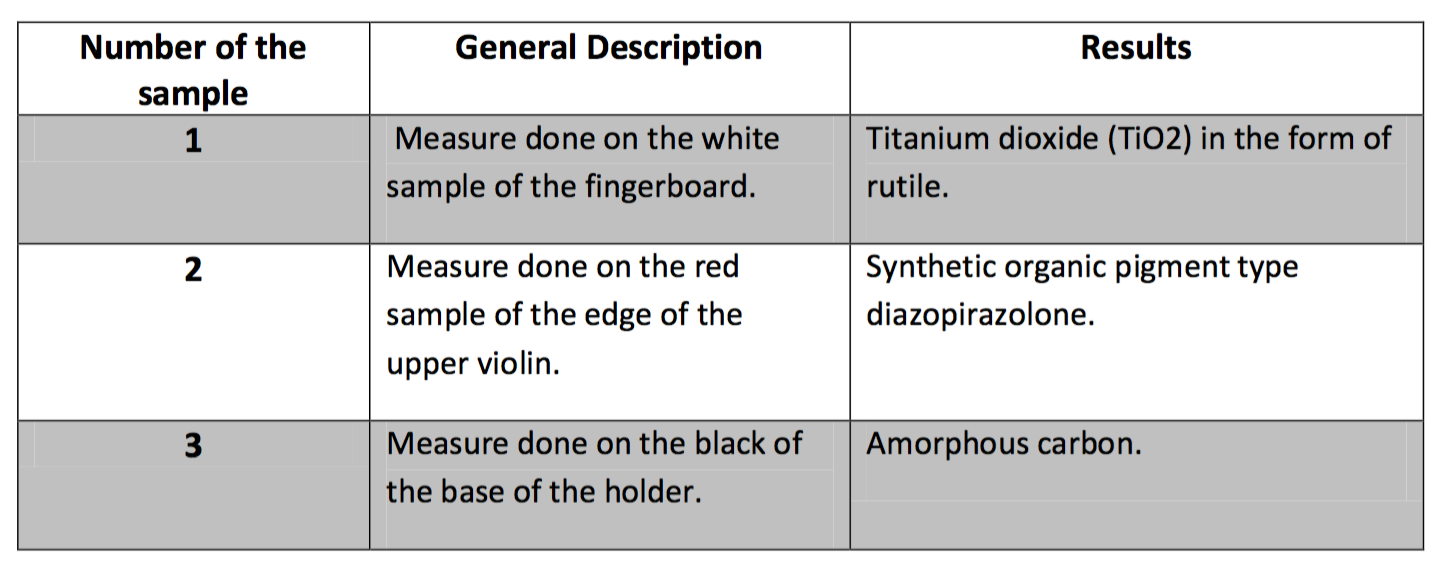

Developed by Dr.(C) Tomás Aguayo / Coordination and editing Mg. Evelyn Aguilera Arce
4.1. Subject
Raman Spectroscopy test results report.
This opinion is issued under the promise of telling the truth, acting with the greatest possible objectivity, taking into consideration both what it may favor and what is likely to cause harm to either party.
4.2. Purpose
To determine if the selected pigments of the synthetic collage attributed to Pablo Ruiz Picasso correspond effectively to the palette of the author and if the period of commercialization of the used pigments is compatible with the date of the work.
4.3. Identification of laboratory responsible for the execution of the test
The study of pigments was carried out in the Vibrational Spectroscopy Laboratory of the Faculty of Sciences of the University of Chile (LEV-UCh), in charge of Dr. Marcelo Campos V. and the analyst Dr. (C) Tomás Aguayo C.
4.4. Applied methodology
4.4.1. Samples
Three sampling zones were selected and used to determine the presence of pigments in sections representative of the work.
The reason for the selection of sample sites is due to the need to avoid the obvious deterioration of the work, which is why non-destructive samples were obtained in small
quantities, such that the work was not affected in its state of conservation. Likewise, the extraction of samples was developed after specifying the absence of repainting, a condition that could be discarded, by means of direct scanning with Digimicro digital microscopy with Dual Axis 27 X 100X lens, with digital captures of resolution of 1280 X 1024, together with UV radiation of 400nm, from Veritart's laboratory.
4.4.2. Description of the sections of the sample selected to the material study of the work attributed to Pablo Ruiz Picasso

Image 4.1.The sample zones are shown in the image with a complete circle

4.4.3. Analytical techniques
Raman spectra were collected using two instruments:
4.4.3. Analytical techniques
Raman spectra were collected using two instruments:
4.5. Summary of results obtained and associated spectra

4.6. Conclusions of this chapter
As laboratory analyzes and studies have been developed, it is necessary to:
The spectrum of the white sample shows the signs of titanium dioxide in the form of rutile. This compound corresponds to a white pigment in itself; however it can be found in many cases in some clays.
According to the research of Millán del Pozo, about the use of titanium dioxide in Europe, the following is extracted:
(...) Titanium dioxide as a pigment, has been used scarcely since 1870 to 1895 and in 1895 it was sold in titanium dioxide preparations in Germany, France, the United Kingdom and Italy, increasing its progressive use as a pigment, which in all probability caused Its marketing (...) Max Doerner in 1890 confirms the satisfactory utilization of the titanium in its mixture with the lithopone, this in itself evidences its use21.
In the form of rutile, the titanium dioxide would have begun to take place around the year 1945, due to its technical-pictorial properties superior to the anatase, another form of crystallization of the titanium dioxide that would have been produced exclusively until the year 193822, However, this explanation of the synthesis and use of titanium dioxide is controversial, since there is evidence of rutile and anatase in pigments of pre-Columbian ceramics23, which implies that these forms of crystallization of titanium dioxide occur
21 Millán del Pozo, G. (2009). Modigliani inédito. Tras la huella de su estilo, p. 185. Editorial Universidad Complutense, Madrid.
22 Duran i Escribà, X. (2011). El artista en el laboratorio: Pinceladas sobre arte y ciencia, p. 56. Universitat de València.
23 Bugliani, F; Di Lello, C; Freire, E; Polla, G; Petragalli, A; Reinoso, M. y Halac, E. (2012). El uso de espectroscopia Raman, rayos X y microscopía electrónica difracción en los análisis de pigmentos de cerámica vaquerías. Boletín del Museo Chileno de Arte Precolombino , 17 (2), pp. 65-74. https://dx.doi.org/10.4067/S0718-68942012000200006
Página 60/136
naturally, without that the pigment must necessarily be synthesized in a laboratory. This evidence leaves behind the possibility of using rutile, anatase or titanium dioxide as an element that chronologically guides an artistic or archaeological piece, nevertheless, titanium dioxide, for its covering properties, is suggested24 and has been commonly used in gouache technique, a condition that makes it compatible with the technique used by Picasso.
Referring to the red pigment, the associated spectrum corresponds to diazopirazolone. This component is part of the group of synthetic organic pigments (POS), which due to their physicochemical characteristics have been used in various applications, from the food industry, to the coloring of polymers, through their use as artistic materials25.
In general synthetic organic pigments (POS) are components with high staining power or hiding power, which are grouped according to the chemical functions present in their structures. In general the pigments formulated in the early stages of the synthesis of the organic pigments were called anilines26. Azo pigments in an early stage were also named anilines, however, that term has become obsolete.
As already indicated, the Raman spectrum of the red sample shows the characteristic profile of a type of synthetic pigment called diazopirazolone, one of the pigments belonging to the sub-group of the diazo pigments.
According to the above, a diazopigment can be identified as aniline, following the logic of the name it received in the period of the first diazopigments synthesis, however, it is clear that at present, the nomenclatures have changed and they are not as general as they used to be.
24 Mayer, R (1992). Materiales y técnicas del arte, p. 122. Tursen Hermann Blume Editors, Madrid.
25 Herbst, W; Hunger, K. (2004), Industrial Organic Pigments. WILWY-VCH, Weinheim B.H. Berrie y S.Q. Lomax (1997). Azo Pigments: Their History, Synthesis, Properties, and Use in Artists’ Materials’ Studies in the History of Art. Monograph Series II. Conservation Research 1996/1997, Washington, DC: National Gallery of Art, 57, pp. 9–33.
26 Eastaugh, N. et al (2008). Pigment Compendium. Butterworth-Heinemann, Oxford.
Página 61/136
Without prejudice of the above, in the cubist period of Picasso, the dazopigmentos were denominated vulgarly like anilines.
Although the sources that directly refer to the use of the anilines in the work of Picasso are not explicit, Philip Ball shows the impact of the use of these pigments in the antipodes of the twentieth century27. At present, museums do not have specific information (due to the recent emergence of material studies as part of the museum research laboratories), which makes it difficult to compare the study and other works of the Spanish artist. However, in the technique known as gouache, anilines were frequently used as dyestuffs by works of various masters of the period28.
In reference to the black pigment from which the amorphous carbon spectrum was obtained, it is important to indicate that it is not an indicator of temporality, due to its use as a material in much of human history, however, it does coincide in part The materials used by Picasso, as proven by Stan Smith29, Judith Collins and John Welchman30, among others.
19 Science Faculty, Universidad de Chile, Santiago, Chile.
20 Director of Veritart. See full CV in pp. 7-8 of the present file.
21 Millán del Pozo, G. (2009). Modigliani inédito. Tras la huella de su estilo, p. 185. Editorial Universidad Complutense, Madrid.
22 Duran i Escribà, X. (2011). El artista en el laboratorio: Pinceladas sobre arte y ciencia, p. 56. Universitat de València.
23 Bugliani, F; Di Lello, C; Freire, E; Polla, G; Petragalli, A; Reinoso, M. y Halac, E. (2012). El uso de espectroscopia Raman, rayos X y microscopía electrónica difracción en los análisis de pigmentos de cerámica vaquerías. Boletín del Museo Chileno de Arte Precolombino , 17 (2), pp. 65-74. https://dx.doi.org/10.4067/S0718-68942012000200006
24 Mayer, R (1992). Materiales y técnicas del arte, p. 122. Tursen Hermann Blume Editors, Madrid.
25 Herbst, W; Hunger, K. (2004), Industrial Organic Pigments. WILWY-VCH, Weinheim B.H. Berrie y S.Q. Lomax (1997). Azo Pigments: Their History, Synthesis, Properties, and Use in Artists’ Materials’ Studies in the History of Art. Monograph Series II. Conservation Research 1996/1997, Washington, DC: National Gallery of Art, 57, pp. 9–33.
26 Eastaugh, N. et al (2008). Pigment Compendium. Butterworth-Heinemann, Oxford.
27 Ball report on La invención del color, the emergence of aniline red before 1853 in the hands of Nicholson y Maule. Ball, P. (2012). La invención del color. Turner Publications, Madrid.
28 Ball refers to the case of Van Gogh, who was one of those who experimented with the use of anilines. Ball, P. (2008). El reino de la luz. En Métode, Universitat de Valencia. Recuperado de: http://metode.cat/es/Revistas/Monografics/Materia-de-arte/El-regne-de-la-llum. While Ana Villarquide also refers to the use of the anilines from the middle of the 19th century "in Spain, England and France, often by painters like Delacroix." These pigments were "defended as good ... because of the translucent quality they possess", although the French pre-Raphaelites and the French impressionists declined their use. Villarquide, J. (2005). La pintura sobre tela II. Alteraciones, materiales y tratamientos de restauración, p. 69. Nerea Editors, San Sebastián.
29 Smith, S. (1994). Dibujar y abocetar, p. 25. Akal Editors, Madrid.
30 Collins, J; Welchman, J. (1996). Técnicas de los artistas modernos, pp. 54-55. Akal Editors, Madrid.